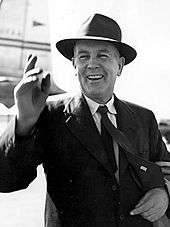Australian federal election, 1951
Australian federal election, 1951

|
|
|
|
|
|
|
Federal elections were held in Australia on 28 April 1951. All 121 seats in the House of Representatives, and all 60 seats in the Senate were up for election, due to a double dissolution called after the Senate rejected the Commonwealth Bank Bill.[1] The incumbent Liberal Party of Australia led by Prime Minister of Australia Robert Menzies with coalition partner the Country Party led by Arthur Fadden defeated the Australian Labor Party led by Ben Chifley.
Results
| Popular Vote |
|---|
|
|
|
|
|
| Labor |
|
47.63% |
| Liberal |
|
40.62% |
| Country |
|
9.72% |
| Independent |
|
1.02% |
| Other |
|
1.00% |
| Two Party Preferred Vote |
|---|
|
|
|
|
|
| Coalition |
|
50.70% |
| Labor |
|
49.30% |
| Parliament Seats |
|---|
|
|
|
|
|
| Coalition |
|
57.02% |
| Labor |
|
42.98% |
Seats changing hands
History
Although the Coalition had won a comfortable majority in the House in 1949, Labor still had a four-seat majority in the Senate. Chifley thus made it his business to obstruct Menzies' agenda at every opportunity. Realizing this, Menzies sought to call a double dissolution at the first opportunity in hopes of gaining control of both houses. He thought he had his chance in 1950, when he introduced a bill to ban the Australian Communist Party. However, after a redraft, Chifley let the bill pass.
A few months later, the Senate rejected the Commonwealth Banking Bill, finally giving Menzies an excuse to call a double dissolution. While the Coalition lost five House seats to Labor, it still had a solid mandate. More importantly, it picked up six Senate seats, giving it control over both chambers.
See also
Notes
References
- University of WA election results in Australia since 1890
- AEC 2PP vote
- Prior to 1984 the AEC did not undertake a full distribution of preferences for statistical purposes. The stored ballot papers for the 1983 election were put through this process prior to their destruction. Therefore, the figures from 1983 onwards show the actual result based on full distribution of preferences.
|
|---|
|
| Federal elections | |
|---|
|
| Referendums | |
|---|
|
- Elections in: Australian Capital Territory
- New South Wales
- Northern Territory
- Queensland
- South Australia
- Tasmania
- Victoria
- Western Australia
|

